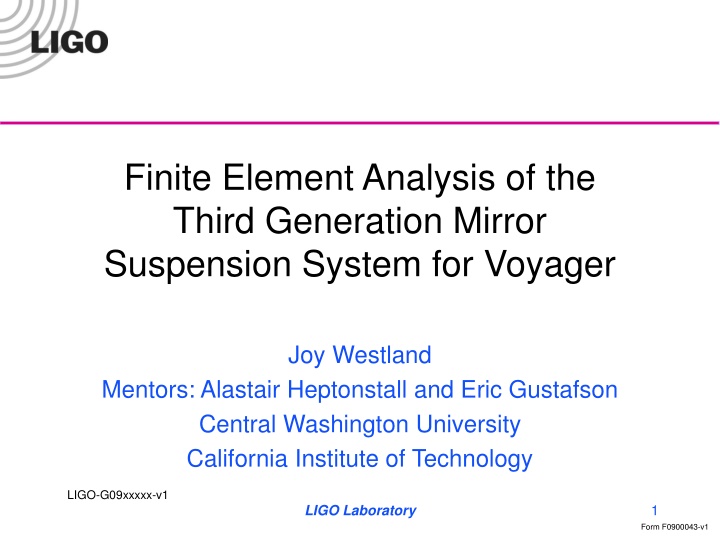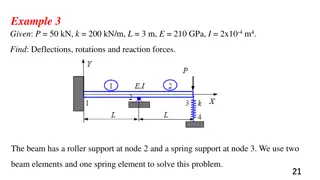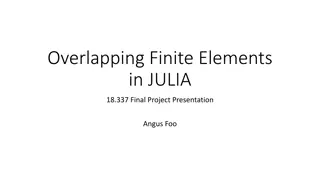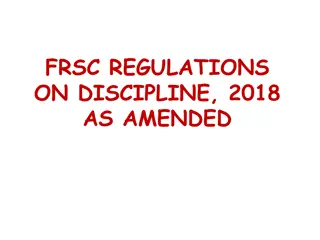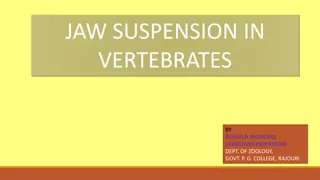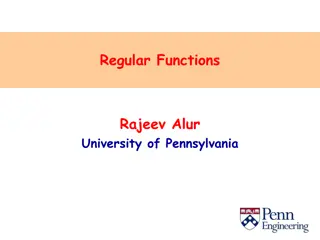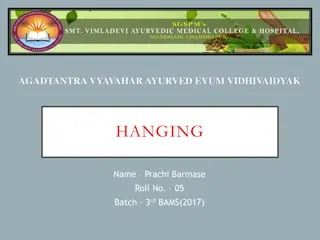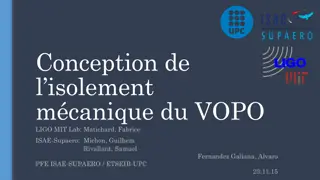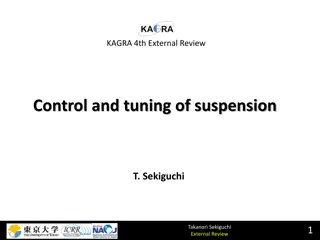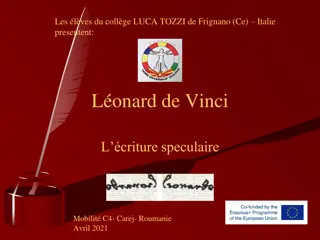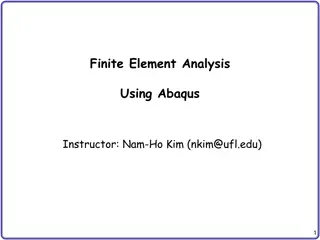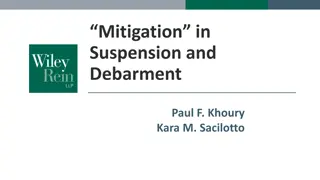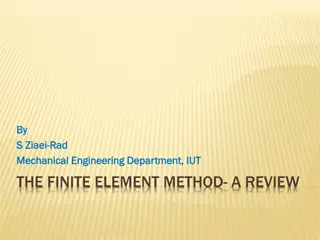Finite Element Analysis of the Third Generation Mirror Suspension System for Voyager
Michelson Interferometer at LIGO measures strain in space-time for gravitational waves. Learn about thermal noise sources, Finite Element Analysis, and thermal energy storage in the mirror suspension system.
Download Presentation

Please find below an Image/Link to download the presentation.
The content on the website is provided AS IS for your information and personal use only. It may not be sold, licensed, or shared on other websites without obtaining consent from the author.If you encounter any issues during the download, it is possible that the publisher has removed the file from their server.
You are allowed to download the files provided on this website for personal or commercial use, subject to the condition that they are used lawfully. All files are the property of their respective owners.
The content on the website is provided AS IS for your information and personal use only. It may not be sold, licensed, or shared on other websites without obtaining consent from the author.
E N D
Presentation Transcript
Finite Element Analysis of the Third Generation Mirror Suspension System for Voyager Joy Westland Mentors: Alastair Heptonstall and Eric Gustafson Central Washington University California Institute of Technology LIGO-G09xxxxx-v1 LIGO Laboratory 1 Form F0900043-v1
The Michelson Interferometer LIGO is a Michelson interferometer measuring strain in space-time for GWs Mirrors suspended to isolate from ground noise Interferometer is so quiet that thermal noise from mirrors and their suspension is a significant noise source aLIGO has quad suspension systems to decrease Thermal Noise (TN) 4 stages 1/f2 per stage seismic isolation Fused silica fibers replace metal fibers Mirror mass is increased from 11 kg to 40 kg Passive and Active isolation Figure 1: iLIGO vs. aLIGO suspension systems provided by LIGO Caltech Laboratory. https://www.ligo.caltech.edu/page/about-aligo LIGO-G09xxxxx-v1 LIGO Laboratory 2 Form F0900043-v1
Thermal Noise Thermal Energy is stored in translation, vibration, and rotation of atoms Brownian motion: Random motion of particles Thermal fluctuations Thermally induced motion of test mass Fluctuation Dissipation Theorem: Relationship between power spectral density of a thermal driving force to the dissipative part of the mechanical impedance (Callen and Welton) Friction in the test mass Internal damping inside test masses Vibrations that drown out signals of GW Future GW require lower Thermal Noise Finite Element Analysis (FEA) will be used to investigate thermal noise in the suspensions ??? =4??? Where: ? =1 ?2? ? ? ? LIGO-G09xxxxx-v1 LIGO Laboratory 3 Form F0900043-v1
Finite Element Analysis Finite Element Analysis: Numerical technique to approximate real world situations given a set of boundary conditions for a specific model Accurate representation of complex geometry Understanding physical reality computationally Program: ANSYS Computer-aided engineering software SolidWorks LIGO-G09xxxxx-v1 LIGO Laboratory 4 Form F0900043-v1
Increasing Complexity of Models in ANSYS Cantilever Bar measuring the mode frequencies Simple Pendulum Calculating the violin modes Lower mass suspension system with wires and ears LIGO-G09xxxxx-v1 LIGO Laboratory 5 Form F0900043-v1
Calculating and Comparing Violin Modes of a Clamped Pendulum Convergence of Meshing: Meshing element size and the frequencies associated with each mode. Look at the consistencies and what element size have all the frequencies converging at. Equation for Violin Modes Figure 2: Convergence element meshing 2] ? 2? ? ??[1 + 2 ? ?? ?+?? ?? ? ??= 2? Where: ?? is the frequency of the nth mode, ? is the tension in the wire, ? is the length of the wire, ? is the moment of cross section (? = Modulus of Elasticity, and ?? Linear Density (mass per unit length) ? 64?4) for cylindrical, ?is Young s Figure 3 Comparison of violin modes (Analytical and Computational) LIGO-G09xxxxx-v1 LIGO Laboratory 6 Form F0900043-v1
Levin Formulation The Levin formulation of the fluctuation-dissipation theorem allows direct calculation of the thermal noise Apply a pressure that mimics the light beam intensity Gaussian profile Thermal Noise: ??? =2??? ?2?2 Strain energies calculated using ANSYS can be used to find the total energy dissipated in the wires ????? ?02 ????? ??????????? where: ?????= 10 7 ??????= ?????= ?????????? LIGO-G09xxxxx-v1 LIGO Laboratory 7 Form F0900043-v1
Applying a Gaussian Force A Gaussian Pressure was applied to the face of a test mass. The strain energies were recorded. Static Structural Model ?2 ??2 1 ? ? = ???2? Where: ?? is 1.56 cm or 0.015 m. LIGO-G09xxxxx-v1 LIGO Laboratory 8 Form F0900043-v1
Acquiring Strain Data Model uses lower mass with wires and ears. Gravity is applied, and a force with a pressure integrated to 1/100 N was applied on the face of the test mass. The wires were fixed at the top. Situation Strain Energy (J) Whole Part 1.2117243 Test Mass Only 1.1207E-05 Both Ears Only 1.106E-04 Wires Only 1.21160259 LIGO-G09xxxxx-v1 LIGO Laboratory 9 Form F0900043-v1
Calculation of Thermal Noise Using Modal Summation ??? = 4??? ? ?[?04? ? The Power spectrum of the displacement noise was calculated analytically Q factor decreases at low temperature Fused Silica Mechanical loss increases ?(?)?02 2+ ?02 ?2 2] LIGO-G09xxxxx-v1 LIGO Laboratory 10 Form F0900043-v1
Research Goals for the Future Calculate the thermal noise using the Levin approach in order to compare and contrast different materials for realistic 3rd generation suspensions This is through calculating W_diss Build a physical full fledge mirror suspension system FEA can be used for thermal analysis of cryogenically cooled mirrors Investigate different material choices such as silica and silicon LIGO-G09xxxxx-v1 LIGO Laboratory 11 Form F0900043-v1
Conclusion We have been able to model the final stage in ANSYS and compare frequencies to an analytical model Using ANSYS static structural model we can extract the strain energy in the wires We have used a basic modal summation method to give approximate measure of noise in room temperature fused silica suspension LIGO-G09xxxxx-v1 LIGO Laboratory 12 Form F0900043-v1
Acknowledgements Mentors: Alastair Heptonstall and Eric Gustafson Alan Weinstein National Science Foundation Caltech LIGO SURF References https://www.ligo.caltech.edu/page/about-aligo Callen, H. B., & Welton, T. A. (1951). Irreversibility and Generalized Noise. Phys. Rev. Physical Review, 83(1), 34-40. doi:10.1103/physrev.83.34 Heptonstall, A. W. (2004). Characterisation of Mechanical Loss in Fused Silica Ribbons for use in Gravitational Wave Detector Suspensions (Unpublished master's thesis). University of Glasgow. Levin, Y. (1998). Internal thermal noise in the LIGO test masses: A direct approach. Physical Review D Phys. Rev. D, 57(2), 659-663. doi:10.1103/physrevd.57.659 Robertson, N. A., Cagnoli, G., Crooks, D. R., Elliffe, E., Faller, J. E., Fritschel, P., . . . Willems, P. (2002). Quadruple suspension design for Advanced LIGO. Class. Quantum Grav. Classical and Quantum Gravity, 19(15), 4043-4058. doi:10.1088/0264-9381/19/15/311 LIGO-G09xxxxx-v1 LIGO Laboratory 13 Form F0900043-v1
